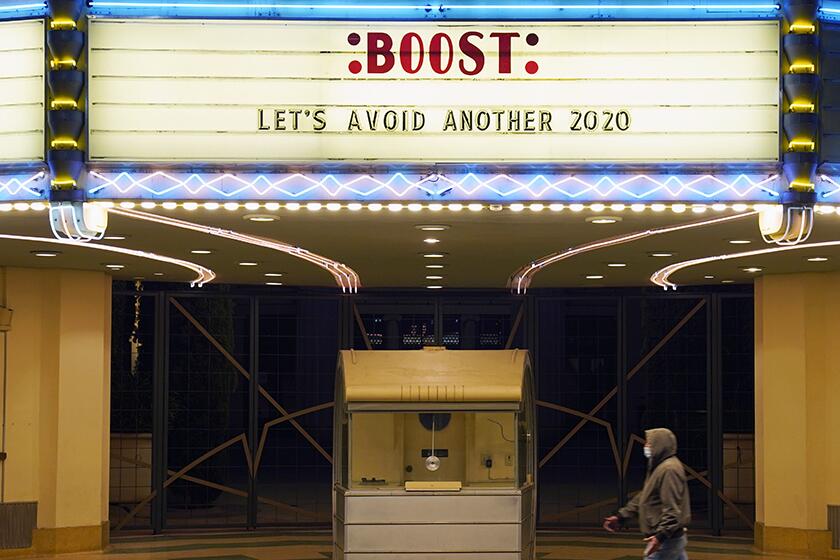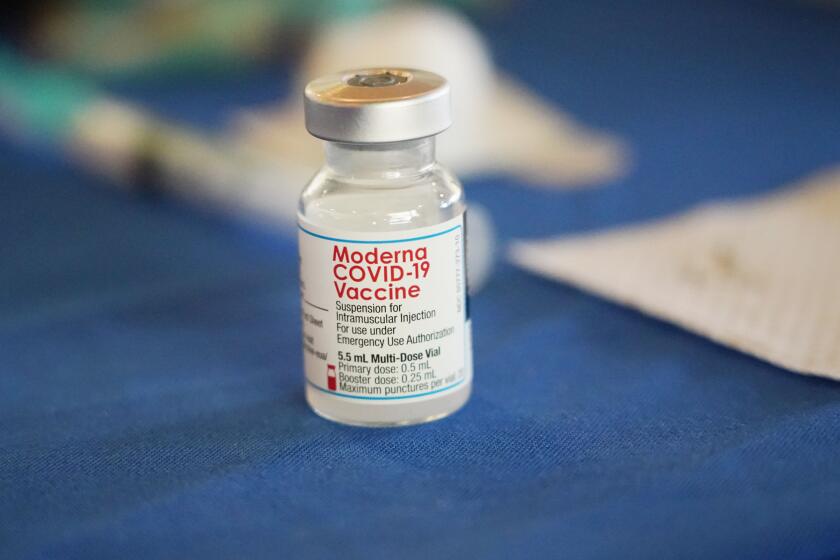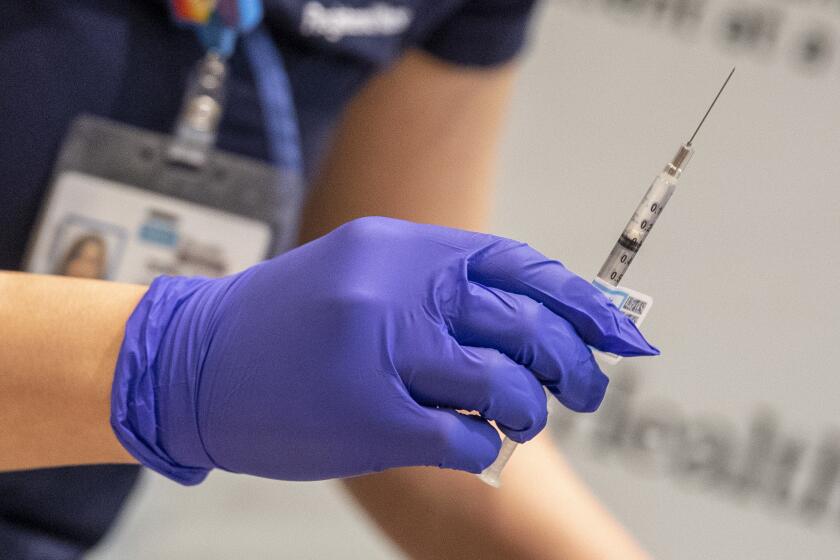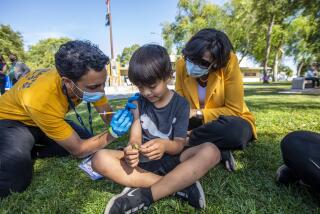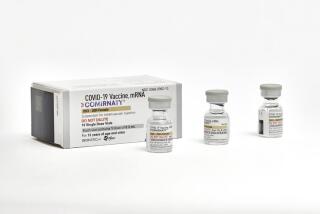Tweaked COVID boosters are close, but how much will they help?
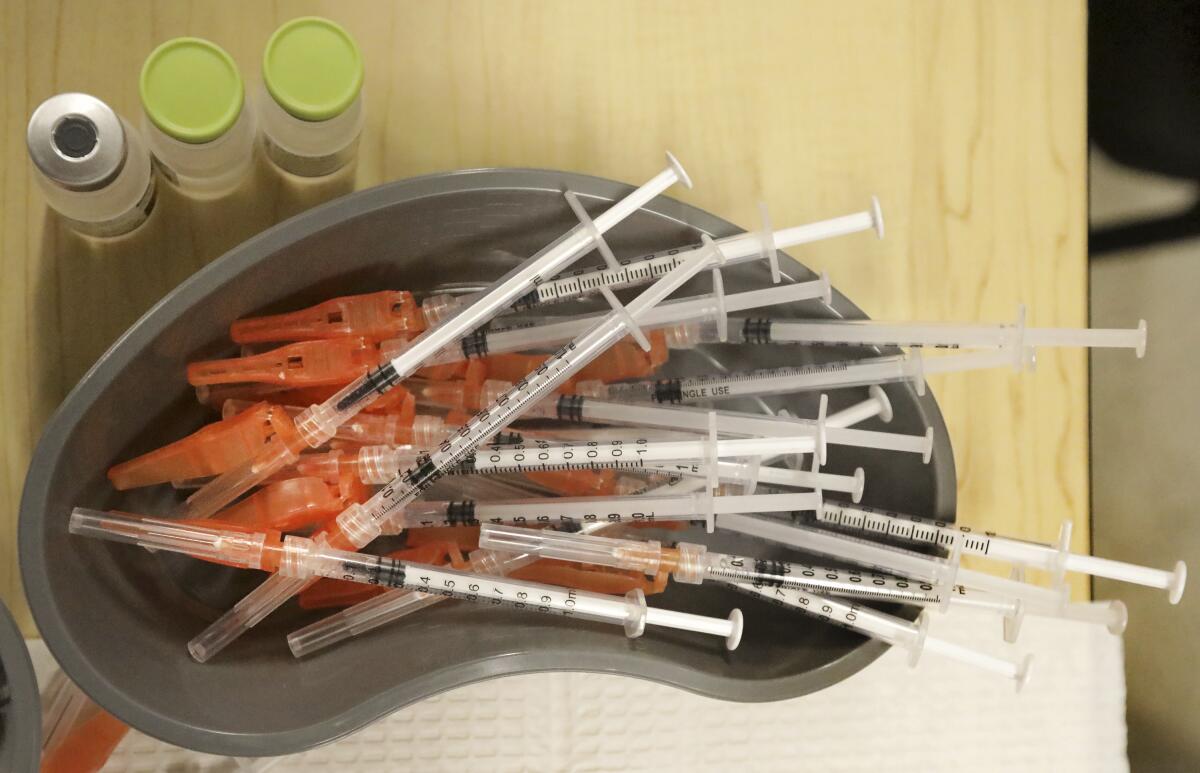
- Share via
COVID-19 vaccines tweaked to better match today’s dominant Omicron strains are expected to roll out in a few weeks, but still up in the air is how much benefit the booster shots will offer, who should get one, and how soon.
Pfizer and Moderna both asked U.S. regulators this week to authorize modified versions of their vaccine — shots that target the BA.4 and BA.5 subvariants as well as the original coronavirus.
The Food and Drug Administration ordered that recipe and now is evaluating what scientists call a “bivalent vaccine,” with a decision expected soon.
Dr. Peter Marks, the FDA’s vaccine chief, said Thursday that once authorized, the tweaked boosters could help right away — while BA.5 infections still are too high — and hopefully blunt yet another winter surge.
Marks said the new boosters could rev up the immune system to prevent not just serious illness but maybe milder infections, too, like the original vaccines did earlier in the pandemic.
“The hope here is that by better matching things, not only will we get that benefit or even more, but we’ll also have that last for a longer period of time,” he said.
Why did the FDA order a modified booster?
BA.5 currently is causing nearly all COVID-19 infections in the U.S. and much of the world. Current COVID-19 vaccines are matched to the coronavirus strain that circulated in early 2020. And while those vaccinations still offer strong protection against serious illness or death, they’re less effective at preventing Omicron infections.
Updating the vaccine recipe is an important but expected next step — like how flu vaccines get updated every year. True next-generation vaccines are still in development.
“We need to give a clear, forward-looking set of expectations,” said University of Pennsylvania immunologist E. John Wherry, who compares vaccine tweaks to the periodic updates of your computer software.
The gamble is that BA.5, or something similar, still will be circulating through the winter. (Vaccines target the spike protein that coats the coronavirus, and the BA.4 and BA.5 spikes are identical although those strains vary in other ways.)
Determining which version of the coronavirus should be used to make COVID-19 vaccines and boosters is an exercise in educated guesswork.
How were the modified shots tested?
Pfizer and Moderna both studied an earlier tweak to their vaccines that targets the original Omicron strain, called BA.1, that hit last winter, as well as even earlier variants.
To evaluate the combo shots, the FDA is using data from human testing of the BA.1-tweaked doses plus tests in mice of the BA.5-targeted version that Marks said show “a very good immune response.”
Human data on the newest tweak will come later in the year to help assess the value of modified shots — especially whether they offer cross-protection if a new mutant comes along, Marks said. Moderna has started a clinical trial of its BA.5 combo shot; Pfizer and its partner BioNTech expect to open a similar study soon.
The U.K. has authorized Moderna’s new COVID-19 vaccine that aims to protect against the original virus and the Omicron variant.
Will they work better?
No one knows. Dr. Paul Offit, a vaccine expert at Children’s Hospital of Philadelphia and an FDA vaccine advisor, said the increase in antibodies in response to the BA.1-targeted shot was “underwhelming.”
“What the administration is asking us to do is to accept this bivalent vaccine as significantly better” than another dose of today’s vaccine, he said. “It would be nice if there were data to support that.”
But while the FDA hasn’t made a final decision, Marks said there’s evidence that the updated boosters are safe and that waiting for more data on their effectiveness would risk another variant appearing before they could roll out.
They “essentially refresh the immune response,” he said. “Granted, it’s still a bit of a guess how long it will last, but this is doing our best.”
Given how outdated the current shots are, an update makes sense, said Dr. Walter Orenstein of Emory University, a former vaccine director at the Centers for Disease Control and Prevention. Though he’d like to see more data, he plans to get the new booster.
Researchers at Caltech have developed a vaccine designed to neutralize multiple coronaviruses at the same time.
Who should get an updated shot?
That’s up to the CDC, which called a meeting of its influential vaccine advisors next Thursday and Friday to help decide.
Pfizer wants to open its updated boosters to everyone 12 and older who’s already had a primary series of today’s vaccine, while Moderna has applied only for adult use.
The CDC will determine if people at highest risk should go first. Studies of doses for younger children are expected later in the year.
A government rollout plan anticipates that people who’ve already gotten their initial vaccinations would qualify for one of the new combination shots, regardless of how many boosters they’ve already had.
When should those eligible get the new booster?
Marks is aiming for a very simple message: “It’s probably going to be everyone who has not had a booster within the past X number of months should go out and get the booster in a timely manner,” he said. Officials still have to decide just how many months, though.
How long to wait after your last vaccine dose or an infection is a critical decision, immunologists agree. That’s because if you still have a lot of antibodies in your bloodstream, they’ll counteract the brand-new antibodies that the vaccine dose is supposed to produce.
So if you already got a booster in July or August and then seek the new combo shot in September, “you’ll receive very little additional boosting from that,” Penn’s Wherry said. He recommends waiting four to six months.
The CDC will weigh in after after considering how many doses will be available in early September versus later in the fall. The Biden administration has purchased more than 170 million doses.
The new booster ‘will become available by early to mid-September,’ if the FDA and CDC authorize shots, a top White House official said this week.
Will people roll up their sleeves again?
Americans have been reluctant to keep up to date with COVID-19 vaccinations. While three-quarters of Americans 12 and older have gotten their initial vaccinations, only half got a first booster shot, despite evidence that they’re crucial to get the best protection against coronavirus variants.
Just a third of people 50 and older who were advised to get a second booster when Omicron arrived did so.
